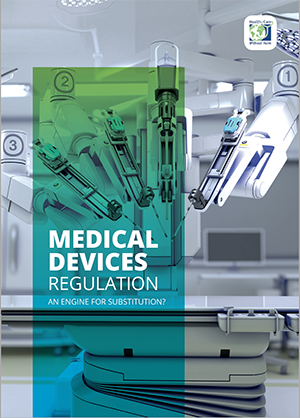Is the Medical Devices Regulation an engine for substitution?
HCWH Europe’s latest publication provides background to the new EU Medical Devices Regulation (MDR), information about the medical devices subject to the new regulation, as well as a snapshot of the medical devices market and the manufacturers of such devices in the EU. This factsheet also assess some of the provisions of the MDR that have the potential to act as an engine for substituting medical devices containing harmful chemicals with safer alternatives.
A history of the Medical Devices Regulation
On 7th March 2017, the European Council adopted new EU rules that overhauled the regulations applicable to medical devices placed on the EU market. The main policy objectives of the revision were to ensure:
- A consistently high level of health and safety protection for EU citizens using these products
- The free and fair trade of such products throughout the EU
- That EU legislation is adapted to the significant technological and scientific progress occurring in this sector over the last 20 years
This regulation is a “supernova” of a regulation in the medical device landscape, with an initial text that has expanded from 60 pages to six times that size. The full transitional provisions are detailed in Article 120, but put simply, the MDR entered into force on 25th May 2017 and will apply as of 26th May 2020.
The problem with medical devices
PVC (polyvinyl chloride) is a widely used plastic - often made more flexible by the use of the phthalate DEHP, long considered to have toxic characteristics. We have known for decades that phthalates leach out of medical devices such as PVC tubing. Alternatives were not available 30 years ago but now there is a choice to be made between safer alternatives or ignoring the potential dangers to patients.
Similarly, Bisphenol A (BPA) has been linked to endocrine disruption; initially developed as a synthetic oestrogen in 1891, BPA was not widely used until the second half of the twentieth century due to the availability of more potent synthetic oestrogens, such as thalidomide. Now BPA is a major part of daily life: from the ink of cash register paper to the linings of beverage cans – and in medical devices.
 According to the MDR, medical devices will only be permitted to contain levels of certain hazardous chemicals above an established limit if a justification is provided. The MDR contains provisions mirroring the REACH requirement for progressive substitution of the most dangerous chemicals when suitable alternatives have been identified.
According to the MDR, medical devices will only be permitted to contain levels of certain hazardous chemicals above an established limit if a justification is provided. The MDR contains provisions mirroring the REACH requirement for progressive substitution of the most dangerous chemicals when suitable alternatives have been identified.
HCWH Europe’s new factsheet not only provides concise information on the new regulation, but also explores the opportunity that the MDR provides for accelerating the phase-out harmful chemicals found in some medical devices.
Learn more in this factsheet and our other publications, which all be found in our EDCs resources page.
